We have found ourselves in Elk, California a couple of times recently. Located about twenty minutes north of Point Arena and twenty minutes south of Mendocino, Elk is a town one can drive into, mistakenly assess that there is no viable market or eatery and keep on going. In so doing, the sojourner would miss a fine little pub, and nice place to eat and a market which will re-open – refreshed and with a new business attitude – in May [2011.]
A walk down the bluffs to the beach reveals artifacts man thought would stand certain tests only to find out that nature had other tests in mind. A chunk of concrete lays half-covered in sand. Weathered by winds and tides, at first the thing looks natural. It is not until one examines the aggregate that it becomes clear that this is a manufacture of man, not nature.
That, and the ironwork imbedded in the carcass. Similarly, a steel rail protrudes from the sand, rusted beyond shape. Paired with another, something once ran here for some reason – something not invented by the coastal Pomo. Yet, ‘ashes to ashes’ is the axiom at work.
Generations ago, San Francisco was built out of straight grained, old growth redwood. The stuff was so plentiful that when the city burned in the late 1800s, it was readily rebuilt – the raw material so cheap and plentiful – only to burn again after the great quake of ’06.
 | |
| elkcoast.com |
The mechanisms of that lumber harvest involved felling trees just inland from points such as Elk. Masterfully, inventive folks, who probably did not enjoy degrees from Stanford or Cal, engineered tracks and cables, wharves and moorings so that the felled timber could be yarded from the forest, milled into lumber and loaded onto schooners or scows in the cove and transported to market.
 |
| elkcoast.com |
That’s probably why these old routes exist snaking inward from the coast. The climate is ideal. Mild, wet winters, cool summers. Sequoia Sempervirens flourished and still do. Little Greenwood Cove, at the base of the bluffs below Elk, perfectly filled the bill as a timber transshipment center during its day.
Now, there’s a Catholic Church, and just up the road, both a Catholic and a community cemetery; a hippy-dippy plant nursery, some elegant inns and B&Bs. Soon the market will re-open. Perhaps people will stop when they drive through. Perhaps, also, they’ll scratch around a bit and discover why this place is this place and begin to wonder about other locales through which they may journey.
***
RESOURCES
Buchanan, Flora and Yerda Matson Dearing, Memories of Cuffy’s Cove and Early Greenwood, 1850-1930, © 1977, 1985, 1996, The Greenwood Hobbyists. A compendium of old photos and Flora and Yerda’s recollections. Miss Buchanan was born in Cuffy’s Cove in 1888. Both she and Mrs. Dearing (born 1894 in San Francisco) taught at Greenwood Elementary School, as well as other schools along the Mendocino County coast.
www.elkcoast.com This site serves as a mini-Chamber of Commerce for this oft-overlooked stretch of the California Coast. The site provides historic photos and a little narrative about the area in a posted piece entitled “Greenwood/Elk: A Town with Two Names.”
 |
| elkcoast.com |
Church of the Open Road Press


















































